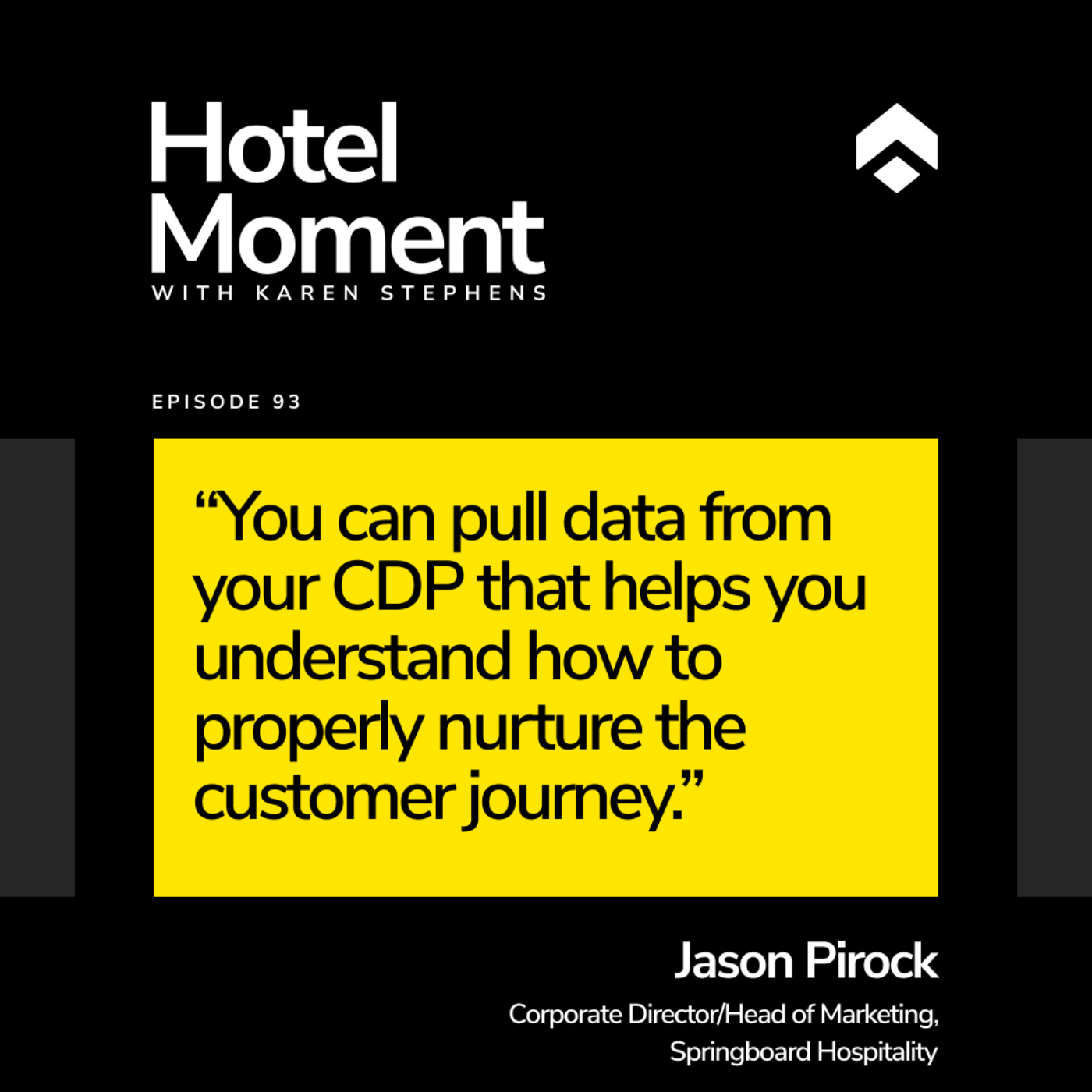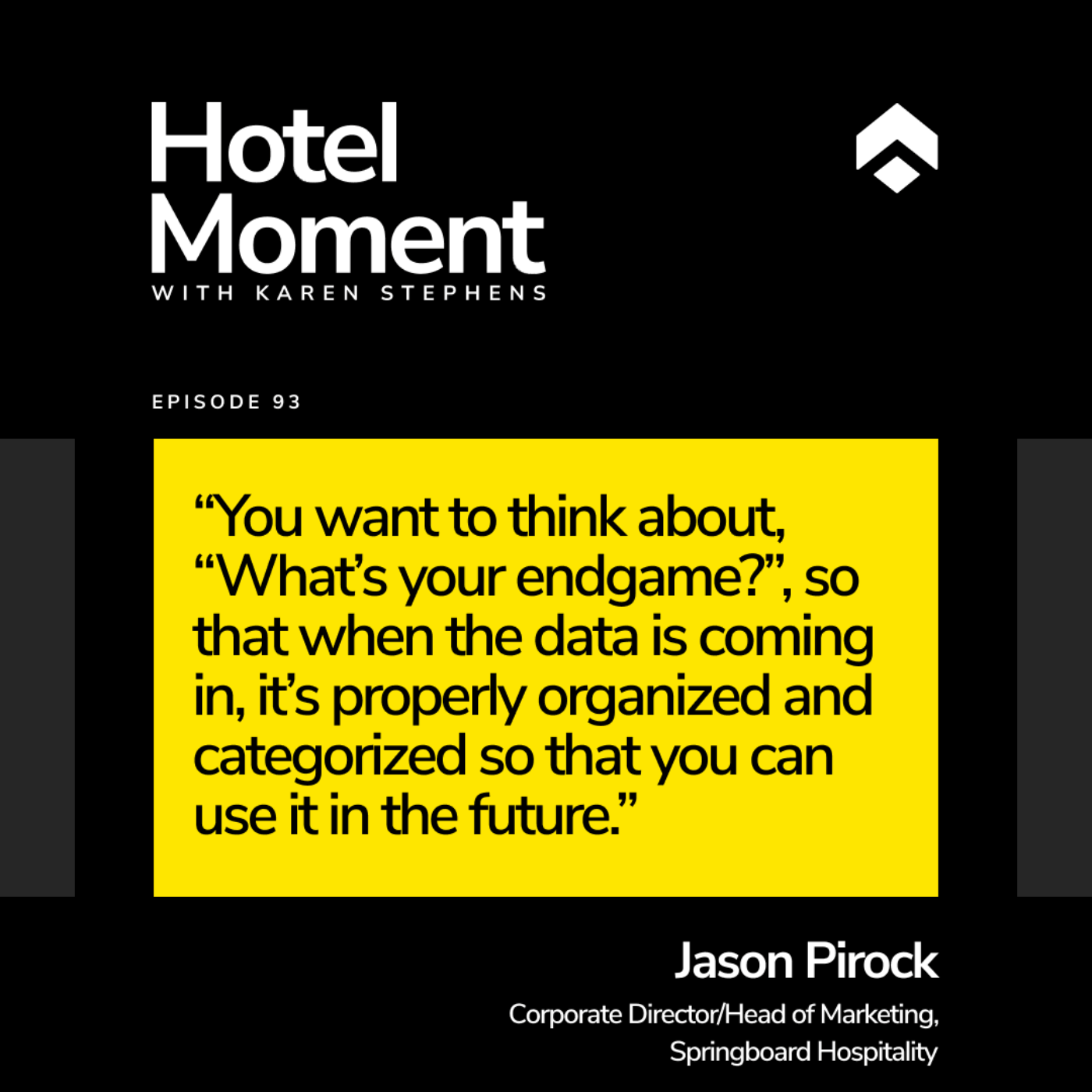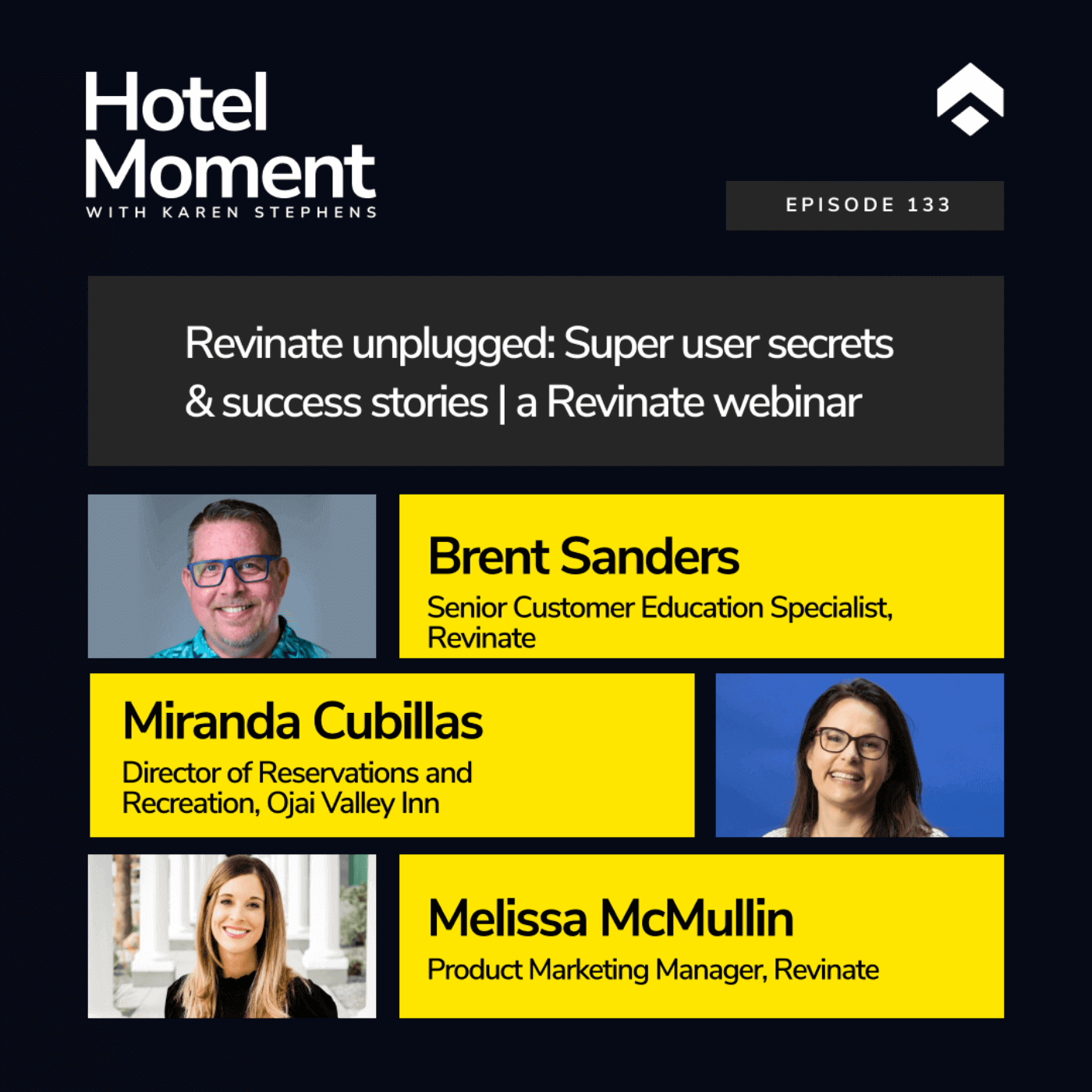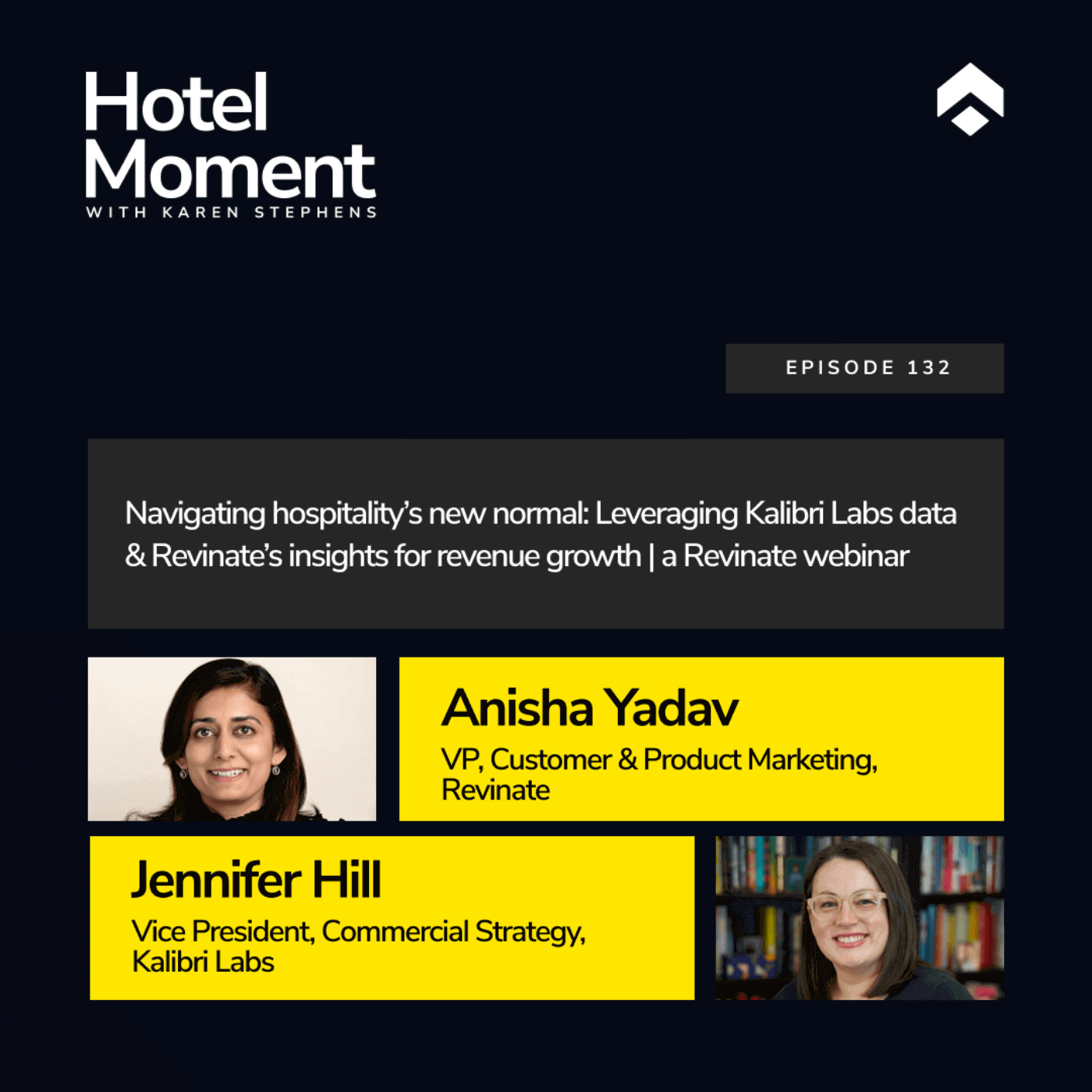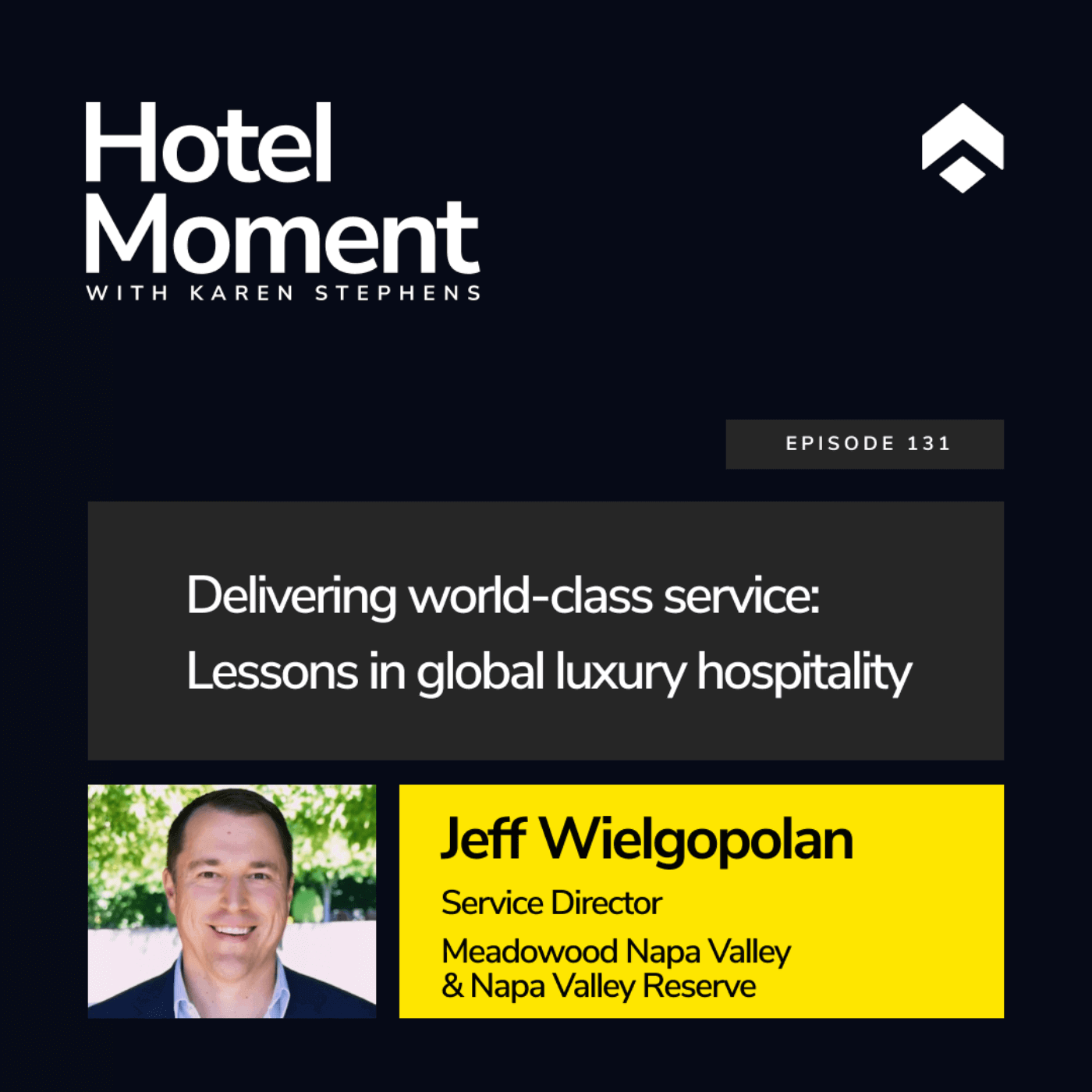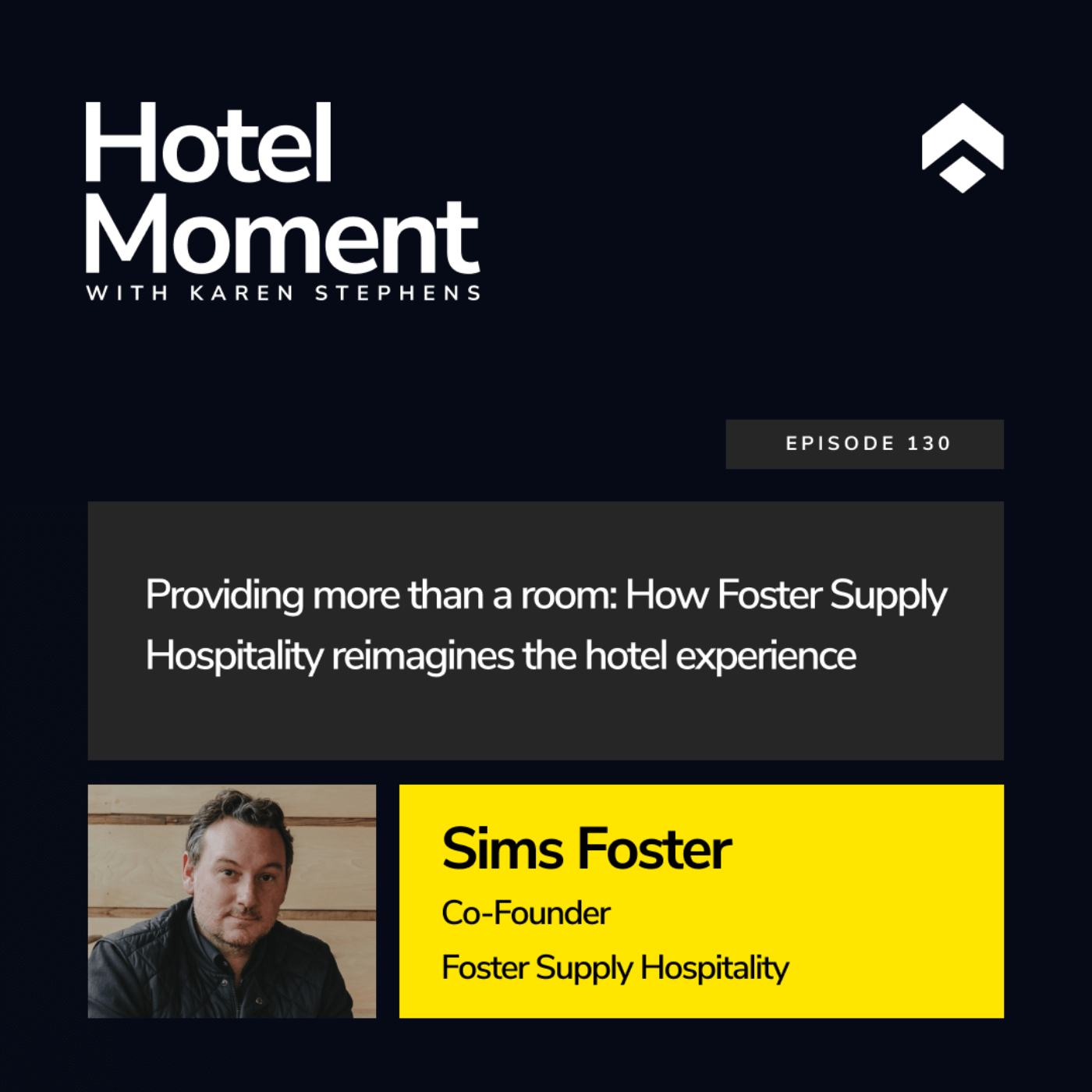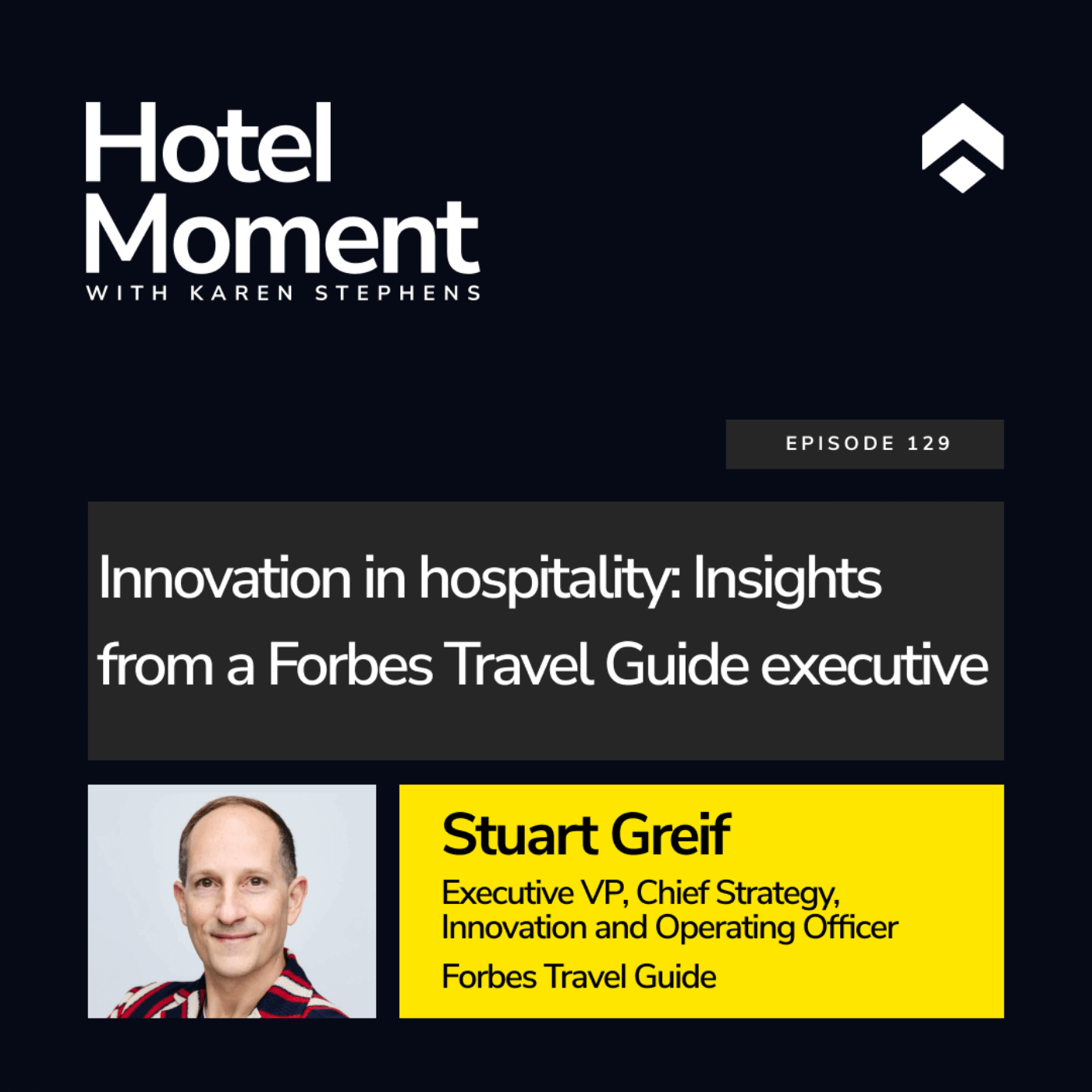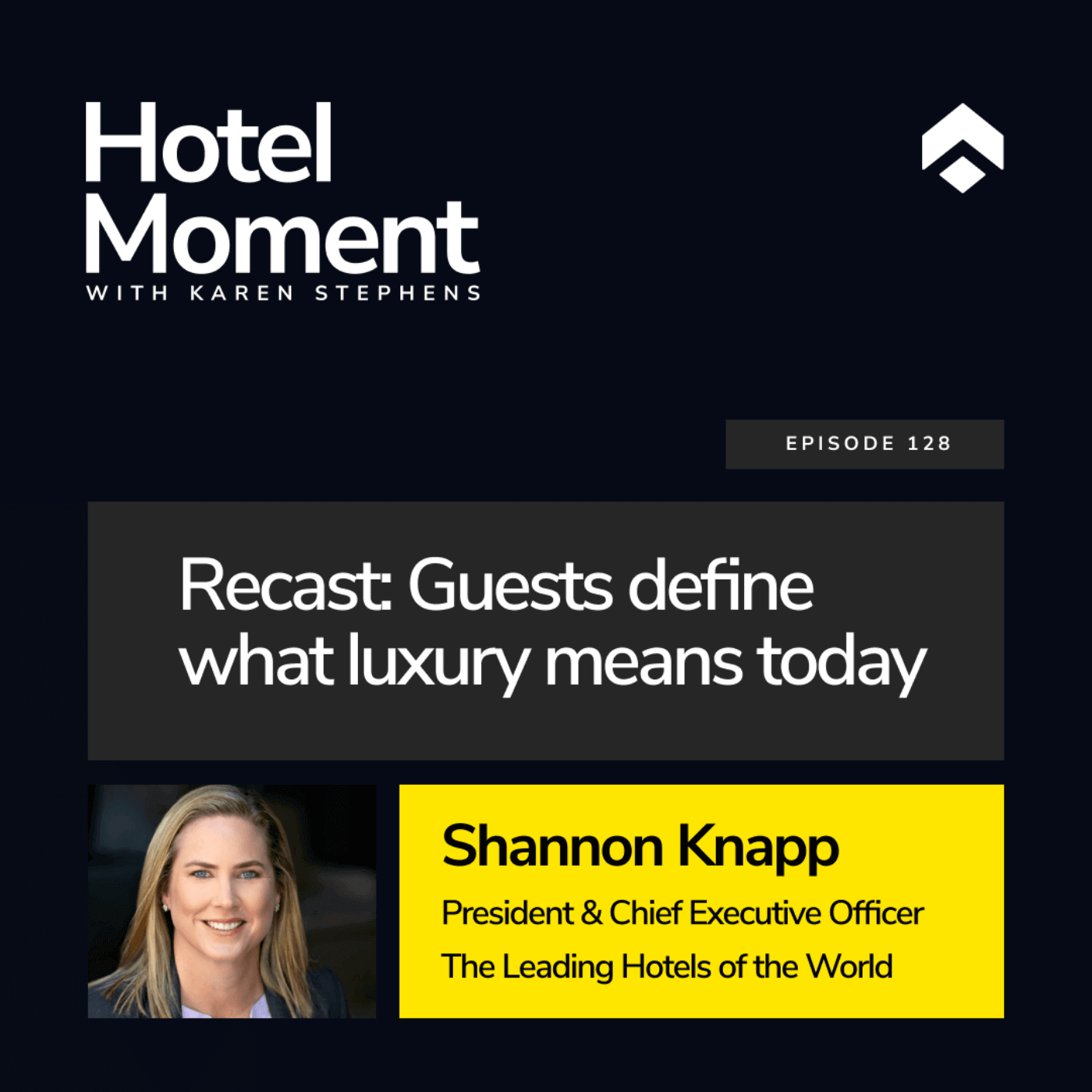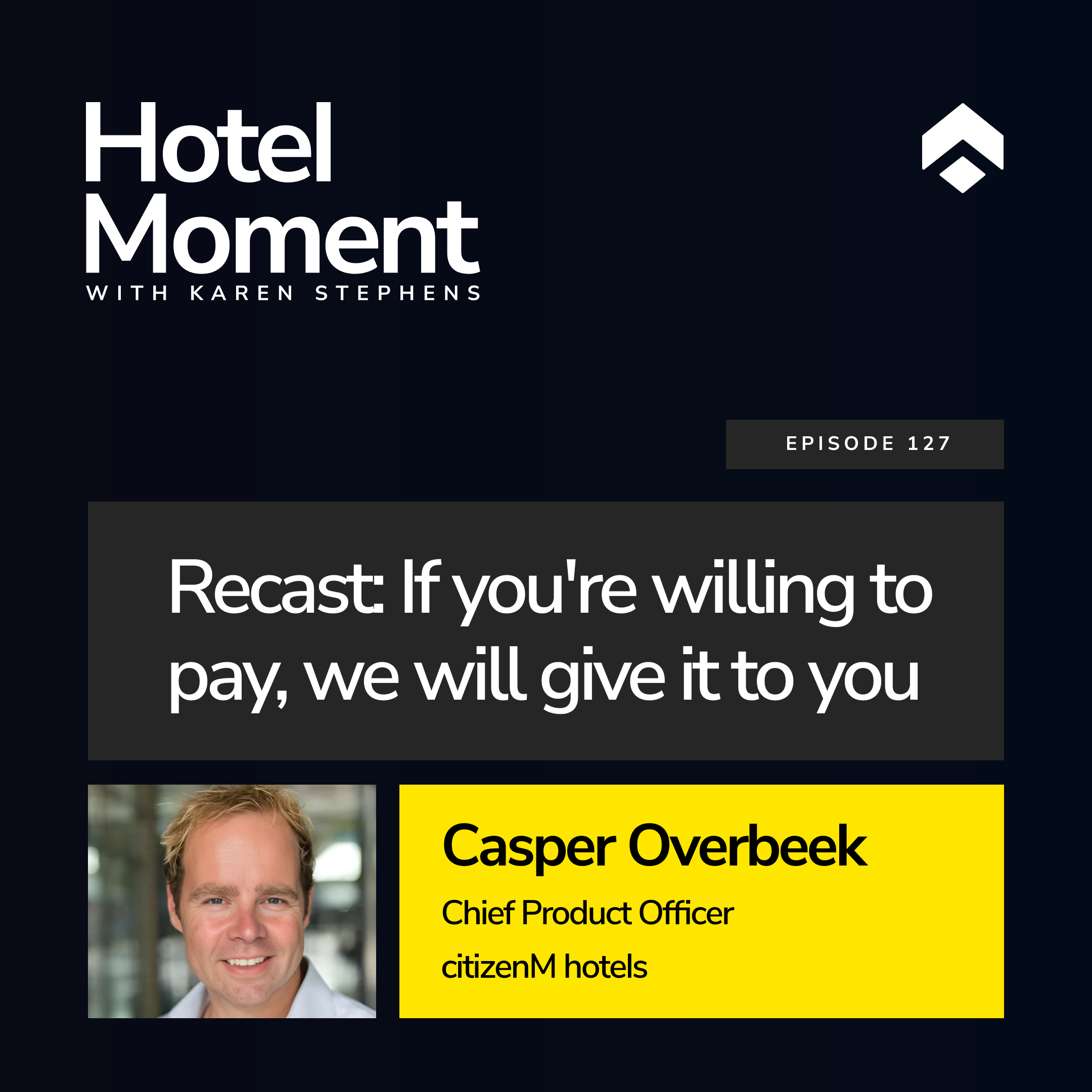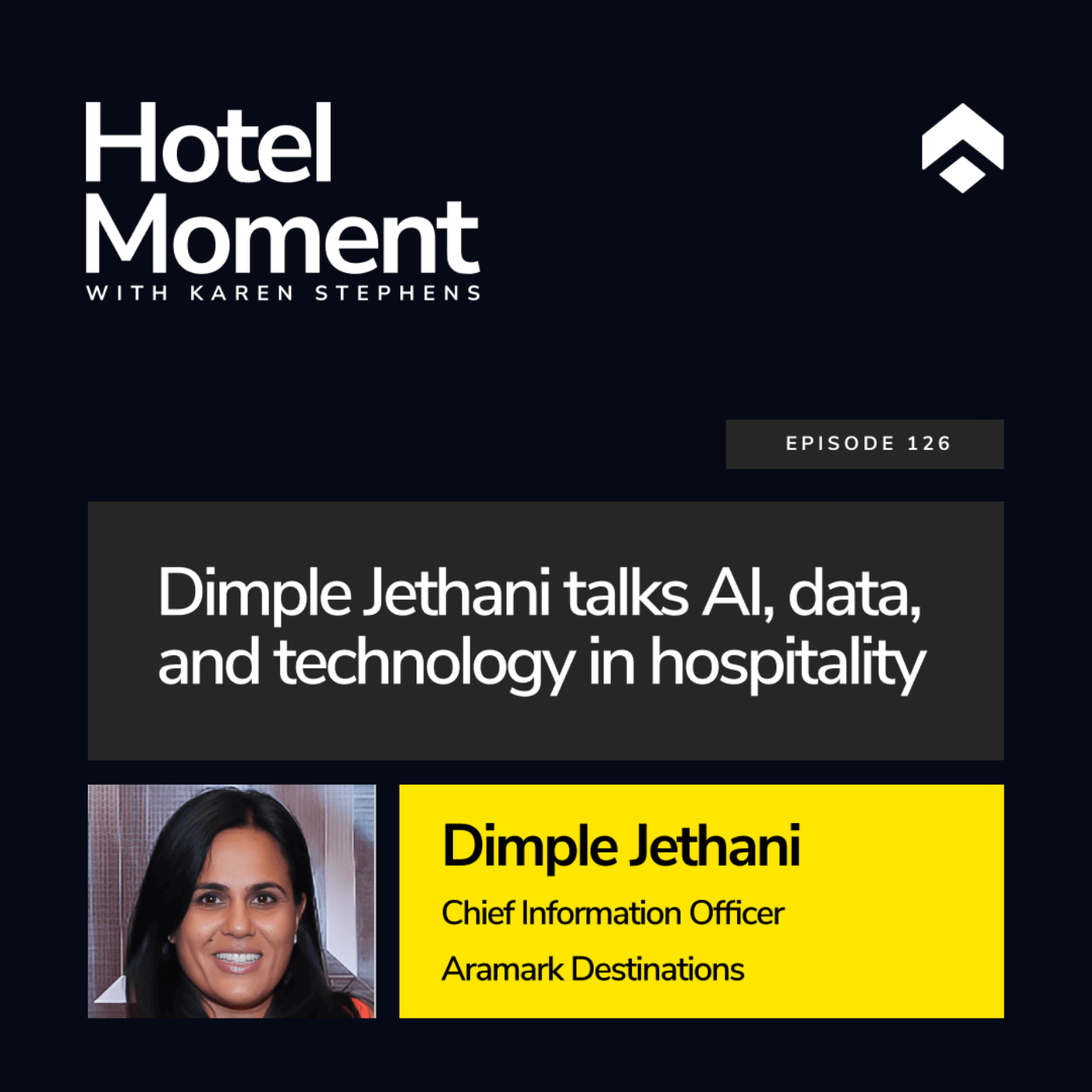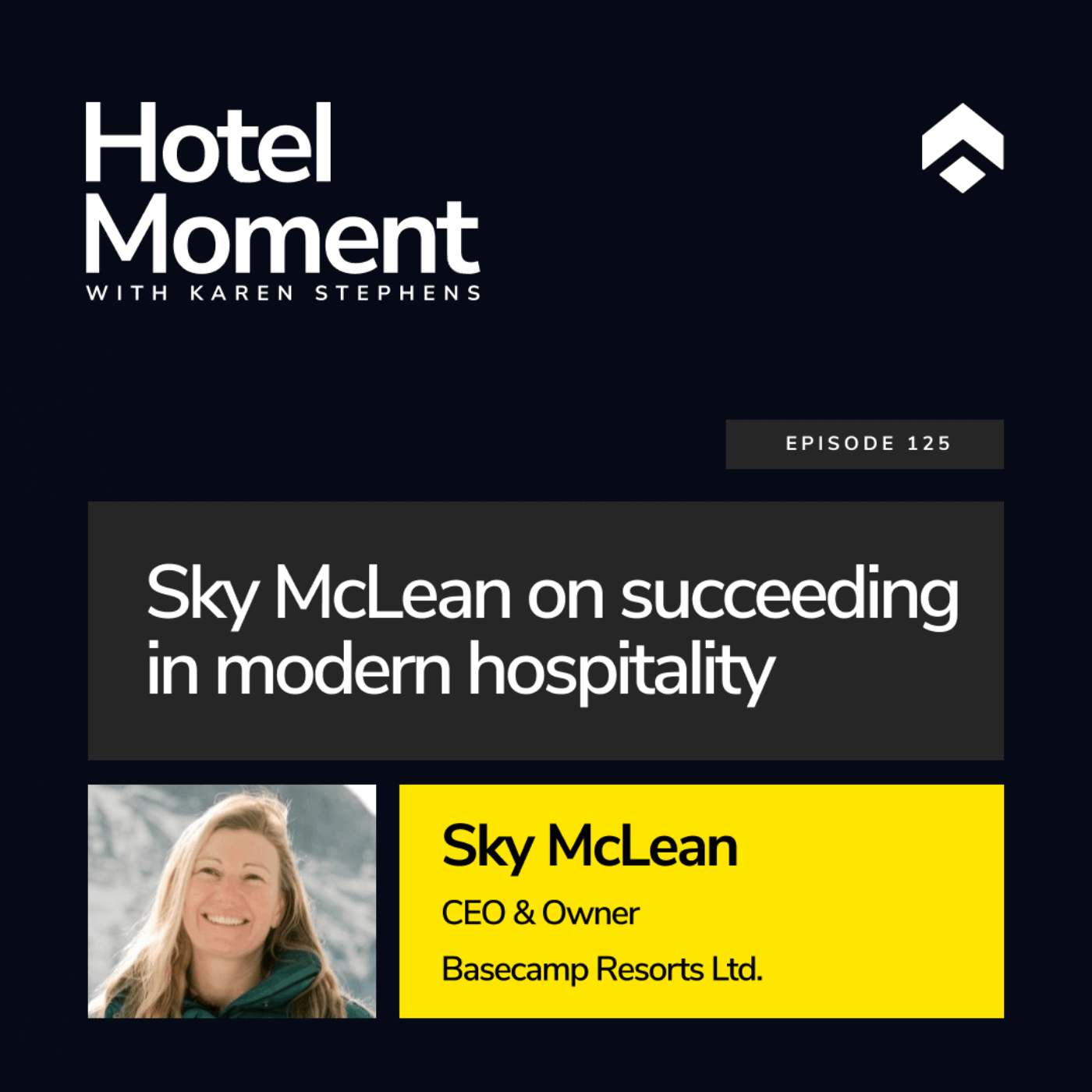Hotel Moment
WITH KAREN STEPHENS


Episode 93
Mastering conversions: Crafting an omnichannel booking journey
In this episode of the Hotel Moment podcast, Jason Pirock, Head of Marketing at Springboard Hospitality and Adam Mogelonsky, Partner at Hotel Mogel Consulting Ltd., investigate how a Customer Data Platform turns guest interactions into conversions on every channel — web, email, text, and voice. Jason explains why nurturing guest relationships becomes second nature with a CDP by enabling guest data application across key touch points in the guest journey.
Listen in and find out how your hotel can achieve record conversion rates and identify guest personas by grounding guest communication in personalization and segmentation with a CDP.
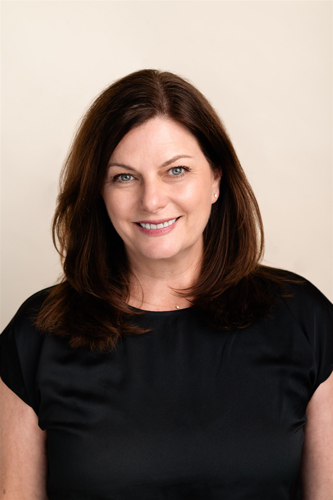
Meet your host
As Chief Marketing Officer at Revinate, Karen Stephens is focused on driving long-term growth by building Revinate’s brand equity, product marketing, and customer acquisition strategies. Her deep connections with hospitality industry leaders play a key role in crafting strategic partnerships.
Karen is also the host of The Hotel Moment Podcast, where she interviews top players in the hospitality industry. Karen has been with Revinate for over 11 years, leading Revinate’s global GTM teams. Her most recent transition was from Chief Revenue Officer, where she led the team in their highest booking quarter to date in Q4 2023.
Karen has more than 25 years of expertise in global hospitality technology and online distribution — including managing global accounts in travel and hospitality organizations such as Travelocity and lastminute.com
Watch the video
Transcript
Intro – 00:00:04: Welcome to the Hotel Moment podcast presented by Revinate, the podcast where we discuss how hotel technology shapes every moment of the hotelier’s experience. Tune in as we explore the cutting-edge technology transforming the hospitality industry and hear from experts and visionaries shaping the future of guest experiences. Whether you’re a hotelier or a tech enthusiast, you’re in the right place. Let’s dive in and discover how we can elevate the art of hospitality together.
Karen Stephens – 00:00:37: Hello, and welcome to the Hotel Moment podcast. I am your host, Karen Stephens, the Chief Marketing Officer of Revinate. And today on the podcast, we’ve got a bit of a treat for you. Today, we are going to be featuring a webinar that was recorded and published by Hospitality Net. And in it, you’re going to hear Jason Pirock, who is the Head of Marketing for Springboard Hospitality, have a conversation with Adam, who is a Partner at Hotel Mogel Consulting Ltd. The topic of this webinar is Mastering conversions: crafting an omnichannel booking journey. So Jason and Springboard Hospitality is a customer of Revinate, and they employ Revinate’s CDP to drive segmentation across their database. So it’s very interesting to hear Jason go in-depth about how he thinks about personalization and segmentation. And I think for me, what I found most interesting was Adam asked him, “What is the definition of omnichannel for you?” And for Jason, omnichannel means anything that drives the guest back to his website to complete that booking. So it’s about driving direct bookings. And it’s also, I think, you know, I don’t want to put words in Jason’s mouth, but I’ve spoken to him before on my own podcast, I know how much time and energy goes into the brand identity for each of the hotels in Springboard Hospitality on the website. So I thought that was a really interesting take. However you get the guests there, get them onto your website to convert and drive that booking. He also talked about personalization and how that is relevant to guests. So I thought that was a really interesting take. So there’s some really great examples about drive markets versus fly markets. And I think it’s really good just to think about the context of your own marketing and how you approach that. And then also, how does a CDP drive conversion? So he talks about cart abandonment, which is a product that Revinate has as well, part of the CDP. And then at the end of the day, each CDP tells a story about the personas or the way that you segment and use the CDP can really reveal the personas of your guests to help you better market in the future. So last but not least, we talk about clean data, and that’s something that they hit on here a lot. Clean data leads to a lucrative content strategy. So it gets rid of the silos and identifies opportunities to target the most profitable guests for more conversions. And to do that, you need a robust piece of technology. You need a CDP. So here you go, Jason and Adam, and I hope you enjoy.
Adam Mogelonsky – 00:02:56: Welcome, and we’re here with a Hospitality Net thematic with Revinate, focusing on the Customer Data Platform (CDP) and all the great things that hotels can do with it. I’m here with my special guest, Jason Pirock of Springboard Hospitality. Jason, how are you?
Jason Pirock – 00:03:14: Doing well. Thank you for having me.
Adam Mogelonsky- 00:03:16: Awesome. Great to have you. This is going to be exciting. So our topic today, the exact name is Mastering conversions: crafting an omnichannel booking journey. So there’s a lot of words in there. Let’s just lay the framework down and let’s start here by defining things. So when we’re talking about a booking journey, can you describe what phases of the guest journey this might entail?
Jason Pirock – 00:03:43: Yeah, so typically I break it down into four phases. I would say first is inspiration. And so inspiration for me is really around how you’re using social media, how are you using some of your third-party partners, just some examples. Next, I go to research. And research is really your online presence. So think about your websites, how you’re showing up on listings, what your reputation looks like. So reviews, those types of things. Then you go into planning, which is content, affiliations, your experiences, your reasons to book, your kind of value propositions, if you will. And then finally, you get into booking. And that’s really mobile, the user experience of the site, those retargeting or conversion tactics, or like email to help you with that piece.
Adam Mogelonsky – 00:04:35: So you touched on my next question there within those four phases is looking at the word omnichannel. And I’m wondering if you could just list off again, just to cover off how extensive and a little bit chaotic your job can be as a marketer is understanding just the totality of what that omnichannel can be.
Jason Pirock – 00:04:56: Yeah, I think that sometimes we overcomplicate what omnichannel is, right? And I think at the end of the day, it’s all things leading to your website, right? If you wanted to simplify it, it’s all things digital and traditional, ultimately leading to your website. And I think that that mix of those channels is really around what you’re trying to achieve, but things that could be included in the omnichannel mix could be things like PR. It could be SEO strategy to drive organic traffic. It could be content. It could be social media, prospecting, retargeting, programmatic. The list kind of goes on. Email. There’s a lot of different channels. But again, you’ve got this whole arsenal of things that make up an omnichannel strategy. But ultimately, it’s about what are the tools that you need to drive your end goal? And where do you need to be in order to make that happen?
Adam Mogelonsky – 00:05:57: And to pick out one other thread there is, you say your website. So we’re talking about conversions off of the direct channel. And a lot of times, part of your strategy, and correct me if I’m wrong here, part of your strategy is the channel shift away from third parties.
Jason Pirock – 00:06:15: Thousand percent.
Adam Mogelonsky – 00:06:16: And to pull on another thread here, we’re talking about conversions through the direct channel. How does segmentation figure into all this?
Jason Pirock – 00:06:25:Yeah, I mean, I think segmentation for me, it starts to really get into this common theme that we keep hearing a lot about in the industry around personalization. And when I hear personalization, I do think in a lot of ways synonymous with segmentation. And segmentation can be something as simple as, are you targeting, is your offer relevant for a drive market versus a fly market? And so just really starting to think about how do you use segmentation to ensure that you’re being relevant to your guests? So you’re getting the right message at the right time, to the right person. And ultimately, that’s what personalization is about. But it doesn’t have to be personalization as one-to-one. It can be personalization as you’re just starting to segment people out. If you’re running a resident offer for a state, you’re not going to be able to get that person out. You’re not going to send that to everybody. You’re going to send it to the state that the resident offer is for. So that’s how I think about segmentation and how you can use it. And that’s more from an email perspective. But what I would also say that I think is untapped in when I hear the word segmentation is there’s a lot of data in segmentation. When I pull segmentations, most of the time I’m pulling it to learn more about the consumer as a whole, and it’s not just about pulling segmentations for my email campaigns. I might want to know what type of repeat guests do we have? When was the last time that this bucket of users or this bucket of guests stayed here? So those are forms of segmentation as well.
Adam Mogelonsky – 00:08:12: Wow. So you talk about pulling data. And that, of course, brings us right back to the nature of our conversation, which is the Customer Data Platform (CDP) and the organization of that data. In various ways. Can you talk about how you use the CDP to help you with your analysis, be that segmentation or trying to find and derive packages or conversions?
Jason Pirock – 00:08:39: Yeah, ultimately, it sort of goes back to the last point, like making sure that you’ve got all this data at your fingertips. And if you’re looking for the answer, chances are, assuming that good data was put in, that you can get that good data out. But really using it to help drive decisions around what are booking windows, what are stays looking like? How are your guests ultimately behaving and interacting? Where are they engaging, not engaging right? And I think that there’s so much power in that data that we already have in our hands to help us determine how we do market to our consumers. I think of examples like you can pull data from your CDP that helps you with lookalike audiences, right? You can pull data from your CDP that is helping you understand how to properly nurture the customer journey. If you’ve seen somebody interact here, but maybe didn’t book, then you’ve got a chance to get back in front of them and get them to book again. So I think it’s not always right there in front of you, but in terms of like, what’s the end game or what is the answer, but the data certainly is there.
Adam Mogelonsky – 00:10:03: So when you say lookalike audiences using a CDP to bring that out, I immediately think of programmatic and search marketing in a lot of ways to really find those customers. Is that how you’re using it in terms of the upper, upper funnel, and upper funnel area?
Jason Pirock- 00:10:22: Yeah, ultimately trying to target folks that have similar attributes, similar, maybe typically it’s less behavioral and more about the makeup of the profile. So if you’re looking to grow that awareness or grow your acquisition, that’s a great strategy is again, to use the data that you have and sort of as it states in its name, take that as a lookalike to find people similar.
Adam Mogelonsky – 00:10:49: That’s great because of course, part of that conversion is getting a wider funnel to feed it into. Could you talk about the relationship between we have the CDP at the upper funnel, getting people to the website. How are you using the CDP to actually drive conversions once people are on the website in terms of could be things like packaging or adaptive messaging, anything of that area?
Jason Pirock – 00:11:15: Yeah, I think most of what we’re using in terms of that conversion base, I mean, there’s things like abandoned cart. I think that is really powerful because you’ve already got these high intent users that were either in your booking engine or they checked out, right? It’s in their cart, but for some reason, they walked away. And likely that is due to pricing. They went somewhere else and wanted to just double check that they got the right pricing. So sort of coming back and again, using sort of, I say nurture because I think we have to be mindful not every consumer reacts to an offer or a discount. It could be starting off with something simple like, “Hey, come back and book with us.” Just a reminder. Another message could be like, “We’ll give you a value add.” Maybe that’s an upgrade upon arrival that doesn’t necessarily cost us anything as a hotel or a hotel company. Or if you’re really not getting them after you’ve made a few attempts, then it’s really coming in a little bit more aggressively with an offer. But using those tools in that regard. And then the other way is really around, as we know, CDPs, that’s our first party data. And sort of back to some of the earlier conversation around, how do you think about your guests? How do you communicate with them? Really using the data that’s in the CDP to understand what is the best way to get them to convert, to get them to take action. And something that I’m seeing, as I said with abandoned cary, it’s not just about throwing an offer at them. It’s about nurturing. And nurturing to me means thinking about the journey, thinking about giving them reasons to book, educating them on why we’re the best place to stay, educating them on what they can do, what they can do while they’re at our property or around our property in the vicinity, in the market or the city, and get them excited and then get them to convert. I’ve just seen a lot more traction and engagement by doing that and not just throwing offers at people every other email or every email weekly.
Adam Mogelonsky- 00:13:30: In a lot of ways, you’d be training the guests to expect a discount that way.
Jason Pirock – 00:13:35: Thousand percent.
Adam Mogelonsky – 00:13:36: I really like that word nurturing because it involves… It involves customer education, but nurturing also implies just good service because you’re helping people move them along. And to pick out one thread there, you said about offering people a voucher for something on site or be that F&B or spa if they have that facility. And this goes back to something that I am a big fan of, which is thinking about total revenue versus just revenue. And while this may involve more of the on-property team or a little bit after booking. I’m wondering about how you work with the rest of the commercialization team to think about total revenue and packaging using the CDP and the segmentation and the analysis you can do to better ensure that guests are utilizing the most facilities while they’re on site.
Jason Pirock – 00:14:29: The first thing that comes to mind is kind of thinking about upsell and add-on opportunities, right? And using technology that typically comes with a CDP or a CRM type of tool where you can introduce that in the journey. And that could be typically I see it in pre-arrival or post-checkout where you’re really starting to introduce like, “Hey, these are the different offerings that we have, or we’ve got these like at one of our properties. We’ve got fire pits, and we do s’mores kits, and we do—”, they end up being like almost like cabanas in a sense. They’re like prime real estate, VIP spots essentially next to the pool. And people love those types of things. And so really thinking about, because for me, it’s about focusing on that lifetime value, which I think is essentially sort of where you’re getting. It’s not just about the revenue that’s coming from the rooms, but it’s like, how can we incrementally build the spend while they’re on site? Right. And so introducing those types of things early with add-ons or upgrades upsells to then enhance their stay and their experience overall.
Adam Mogelonsky – 00:15:44: Yeah, and now you introduced another term, lifetime value, customer lifetime value. A little bit of difference between those two metrics. But what I love about those two metrics is that they’re measuring not just the entire single guest journey, but guest journeys across multiple stays and multiple properties. Is that how you’re thinking about lifetime value?
Jason Pirock – 00:16:05: Yeah, a little bit of yes and no. I mean, I think that the way that our portfolio is set up is we’re a house of brands, we’re a house of independent hotels. And so the focus ends up being a bit more on the individual hotels versus a brand where they’re staying at multiple locations. But yes, we wanna look at, to your point, that total revenue while they’re on site, but also how do we think about getting them, having a great experience, coming back multiple times, that loyalty, that repeat, gas to get us to that lifetime value. And I think it’s something that we as an industry probably don’t focus on enough. I think we’re a bit dated in terms of, or maybe behind the eight ball in terms of the technology that exists to bring and connect all of those data points together. But it is a great way to really, really measure the effectiveness of what you’re doing, especially when it comes to loyalty, which is something that we should all have in mind.
Adam Mogelonsky – 00:17:11: Another word you mentioned earlier was the word incremental or incrementally. And the whole thing with a CDP is that it’s bringing the data together and then it takes really intelligent people such as yourself to ask the right questions of that data in order to guide commercial decisions. And I’m wondering, within the context of the word incremental, if you could talk about some of the initial steps you’ve taken with the CDP in terms of that data analysis and integration and what your vision is for the future uses of the CDP now that the data is coming together in ways that you can interpret it and ask really detailed questions.
Jason Pirock – 00:17:53: I think it does stem back essentially to that lifetime value. Like now that assuming that you’re in a place where you’ve got. Clean data, you can start to analyze and find those trends and find those opportunities, right, to help drive more revenue. And I think by using the data that’s there, and seeing what those patterns are, and what some of those behaviors are can then help you create the content strategy that will ultimately drive more revenue. So for example, it could be something like, “Wow, this property is seeing a really high propensity in wine drinkers.” Well, maybe there’s an opportunity to do more of like a wine-related activity on-site that we could sell tickets to that ultimately is driving more overall revenue for the property. So I think those are ways that we can start to get a little bit more, have a little bit more fun. It’s just that.
Adam Mogelonsky – 00:18:50: Well, wine is fun.
Jason Pirock – 00:18:53:Yeah, wine’s always fun, of course.
Adam Mogelonsky – 00:18:55: Yes. I’m wondering if you could break that down, because obviously I’m a big wine lover, and I’d love to see more events like that. But if you talk about the actual data integrations there, the actual plumbing of all that, are you pulling data from the POS via the CDP into a CRM? Can you talk a little bit about the specifics there, the blocking and tackling of how you’d set that up?
Jason Pirock – 00:19:18: Yeah, I think the way that you’d have to really think about it is, what are, outside of rooms, what are those touch points that guests are interacting with on site? And so those buckets typically would be, to your point earlier, spa. I think there’s outlet in terms of restaurant or bar. I think there’s in-room dining you should be thinking about retail because there’s a lot of properties that might have retail. And if you get into clubs or membership types of things, that might be sort of a whole different component. But I think first, once you know what those touch points are, are they all properly integrating into your CDP? And are they mapped appropriately? And when I say mapped, I think ultimately you want to think about, okay, what’s your end game? What are you ultimately trying to achieve? What do you want to learn? So that when the data is coming in, it’s properly organized and categorized that you can use it in the future. So that could be something like you’re seeing that Joe Smith Jr has gone into retail bottle of wine, in-room dining, or a glass of wine the night that he arrived. Maybe at dinner he had a couple of glasses of wine, and you’re starting to grab, “Okay, he’s definitely a wine lover.” It would be even cooler if you knew exactly what type of wine that it was, because where you start to drive loyalty is when he shows up after his flights and you’ve got that bottle in his room, that would be sort of like the ultimate case. But those are ways that I would start to think about it. Right. So thinking about where are the places that it could come from and then how is it organized and mapped within the CDP so that you ultimately know how to use it when the time is right to deploy.
Adam Mogelonsky – 00:21:22: The mapping is so important because one of the issues you mentioned on this earlier is that there’s so much data. So part of that is how you organize and focus that data around what each team member needs to know.
Jason Pirock – 00:21:37: A thousand percent. And I think that’s such a missing component when it comes to data. I think first of all is understanding the importance and the power of data. I think second is consistency and how you’re tracking and tagging so that you can at least see the data. And then I think to the point we just made, it’s the organization and what do you ultimately plan as that output. Because I think if you know what the output is going to be and you know how you want to use some of this, I think that can answer some of the questions preceding. But I’ve seen in so many cases where if you’re not taking care of it upfront, it ends up being this massive domino effect that just hurts you in the long run. So invest the time to get it right up front.
Adam Mogelonsky – 00:22:30: And yeah, that’s the measure twice, drill once mentality. So if you’re planning, you’re strategizing the mapping of the data, what’s your process for coming up with the best way forward?
Jason Pirock – 00:22:44: Yeah, that’s a really good question. I think that ultimately, you want to pull out what are your sort of your key categories. I think at the end of the day, I think of buckets like zip code is more important than address. I think of if you’ve got an attribute field, depending on how detailed you can get, because you’ve got to be mindful too, you don’t want to get so detailed that you created all these unnecessary sort of nuanced fields, you do want to still try to find some ways to categorize and bucket it. So I think that maybe the best place to start, and I’m thinking on like an individual hotel level is, do you know the persona of your ideal guest or what your guest is today? And if you don’t, map that out. And I think there’s ways that you can start to kind of think about that with data that you do have and then thinking about who you ultimately want to attract. And then sort of from there, break it down to help you understand how you might wanna lay out some of that mapping. Now, if you’re a brand or you’ve got multiple properties, maybe you do that with a few different properties to start to see trends that you would then ultimately figure out what are those sort of tags or what does that mapping look like? Does that make sense?
Adam Mogelonsky – 00:24:11: It makes perfect sense to me, especially when we’re thinking about the development of segments and personas and how that can be a lot more data-driven nowadays than just weather vane, looking around to try and go about that and also the 20th century assumptions about the three main segments of group, corporate, and leisure. Or leisure transient. I’m wondering, there is an emerging main segment that the CDP can really help with, and that is bleisure or blended travel. Can you talk about some of the ways that you’re thinking about using the data to better target those segments for your hotels?
Jason Pirock – 00:24:56: Length of stay or extended stay, I think is a really simple, easy way to sort of hone in on that. And I feel like the industry is always looking to solve for, for midweek, right? Or those lower volume kinds of days. And I think that using your CDP to understand what types of people are checking in, checking out on a Sunday or checking in on a Friday, right? Those are things that you could kind of look at and see if there’s a way to entice them to come in a little bit earlier, stay a little bit longer, right? And I think that can help drive. Typically, that’s gonna be more of a bleisure guest. They’re coming in for a conference. They maybe wanna stay a little bit longer, or they’re coming in for a meeting, and you’re trying to entice them to come a little bit earlier. I think that those are the types of things that you can look at within your CDP and then ultimately create that story. Create that story around why you should come in early and give that inspiration. For example, if I’m checking in on Monday for meetings, maybe I’ll send an email to you around, why don’t you come in on Sunday? We’ll give you a great rate. That’ll give you a chance to unwind, relax, rehearse for your meeting, have a great meal with us. Those are all things that we can start to kind of think about. And then on the flip side with conference goers, we’re seeing a lot more of that extended stay, right? “I’ve already made the trip for my business meetings or for a conference that’s in market. Why don’t I just make a weekend out of it and just, you know through Sunday or Monday and make a vacation out of it?” And so I think there’s ways that, you know, you could ultimately look at segmentation based off of consumer behavior or consumer actions to be able to get in front of them.
Adam Mogelonsky – 00:26:53: Well, there’s one other aspect to blended travel. You’re talking about extending the stay, shoulder nights, huge applications, and tremendous value for hotels. The more data, you can have to properly find those personas is amazing. And it belies a ton of work to properly do that. So kudos to you and your team. The other side of leisure travel is looking at it from a rev pag or revenue per available guest. And this is what’s being described as the plus one travel where one guest is coming in for a conference or a meeting, and you wanna incentivize an extra night so they can prepare or relax afterwards, but due to the nature of remote work nowadays, the spouse could also come in and work on site and utilize the hotel’s facilities while the other is off the conference or the meeting. Are you thinking about using data and marketing in that respect to blended travel?
Jason Pirock – 00:27:58: Honestly, we’re not there just yet, but I do really like the idea and see some definite opportunity. I mean, as someone who does a lot of work travel, I could see there being some value there. I mean, if you think about it, yes, you’re already getting the revenue for the room, but with an additional guest or maybe two, maybe there is upgrade opportunities. You’re obviously going to have ancillary spend in outlets, or maybe there’s resort pass type of concept that kind of comes into play to use the rest of the facilities. I don’t know, just thinking about things without having too much time to think about it. Those are things that sort of come to mind, but definitely an interesting concept.
Adam Mogelonsky – 00:28:42: Well, I just really like hearing your thought process on how you’d approach that, because at the end of the day, it seems like you’re using the data and the organization of that data via the CDP to really help you better understand your mapping and to, as an adjunct for your process, to really help guide hotels towards more profitability and more throughput.
Jason Pirock – 00:29:08: Absolutely. And listen, at the end of the day, I mean, it can all be overwhelming. Data is absolutely overwhelming. But I think it’s about starting small. And I think it’s about even getting 10% of the way is better than where you were before. So it doesn’t have to be perfect. And I think that really applies to the comment on the mapping, right? I mean, you’re never going to be 100% accurate, your guest profile could change over time, too. So I think that’s something to keep in mind. And so keep it simple, chip away.
Adam Mogelonsky – 00:29:41: So looking ahead to the future, do you have any closing thoughts for the future of marketing and segmentation and nurturing the guest journey and conversions by using the CDP?
Jason Pirock – 00:29:57: Yeah, I think that one thing that probably stands out to me, as you said, that is, leverage automation where you can, right? And what I mean by that is that we’re all busy. We all get pulled in a lot of different directions. And in many cases, you’ve got these stacked days. And so remember the power of automation and things that you can take advantage of by setting up and in a little bit of forgetting, right? A little bit of set and forget, right, that can maybe doesn’t always drive a ton of revenue, but it is generating more data for you, and it’s keeping you top of mind. So those are all really important because at some point people are going to make a decision and hopefully it’s with you. And so I think kind of keeping that in mind. And then I think just in terms of like larger omnichannel strategy, to me, it’s about consistency, making sure that you’re saying the same thing across all channels, that you’re integrated, that you’re really thinking about what are all the tools in my toolbox that can help me achieve what my ultimate goal is. And yeah, those are kind of some of the things that come to mind..
Adam Mogelonsky – 00:31:12: Well, those are all incredible things that hotels should think of. And I can’t thank you enough, Jason, for this conversation and just data dumping all your knowledge onto us. It really is something that every hotelier should be mindful of going forward in terms of how they can use every tool at their disposal.
Jason Pirock – 00:31:31: Thank you. Yeah, thank you so much for the time. I really enjoyed the conversation.
Outro – 00:31:40: Thank you for joining us on this episode of Hotel Moment podcast by Revinate. Our community of hoteliers is growing every week, and each guest we speak to is tackling industry challenges with the innovation and flexibility that our industry demands. If you enjoyed today’s episode, don’t forget to subscribe, rate, and leave a review. And if you’re listening on YouTube, please like the video and subscribe for more content. For more information, head to https://www.revinate.com/podcast/. Until next time, keep innovating.
Hotel Moment
WITH KAREN STEPHENS


Be the first to know when a new episode drops
This site is protected by reCAPTCHA and the Google Privacy Policy and Terms of Service apply. View our Terms & Conditions here. *Required fields.

